2006 INFINITI M35 seat adjustment
[x] Cancel search: seat adjustmentPage 3065 of 5621
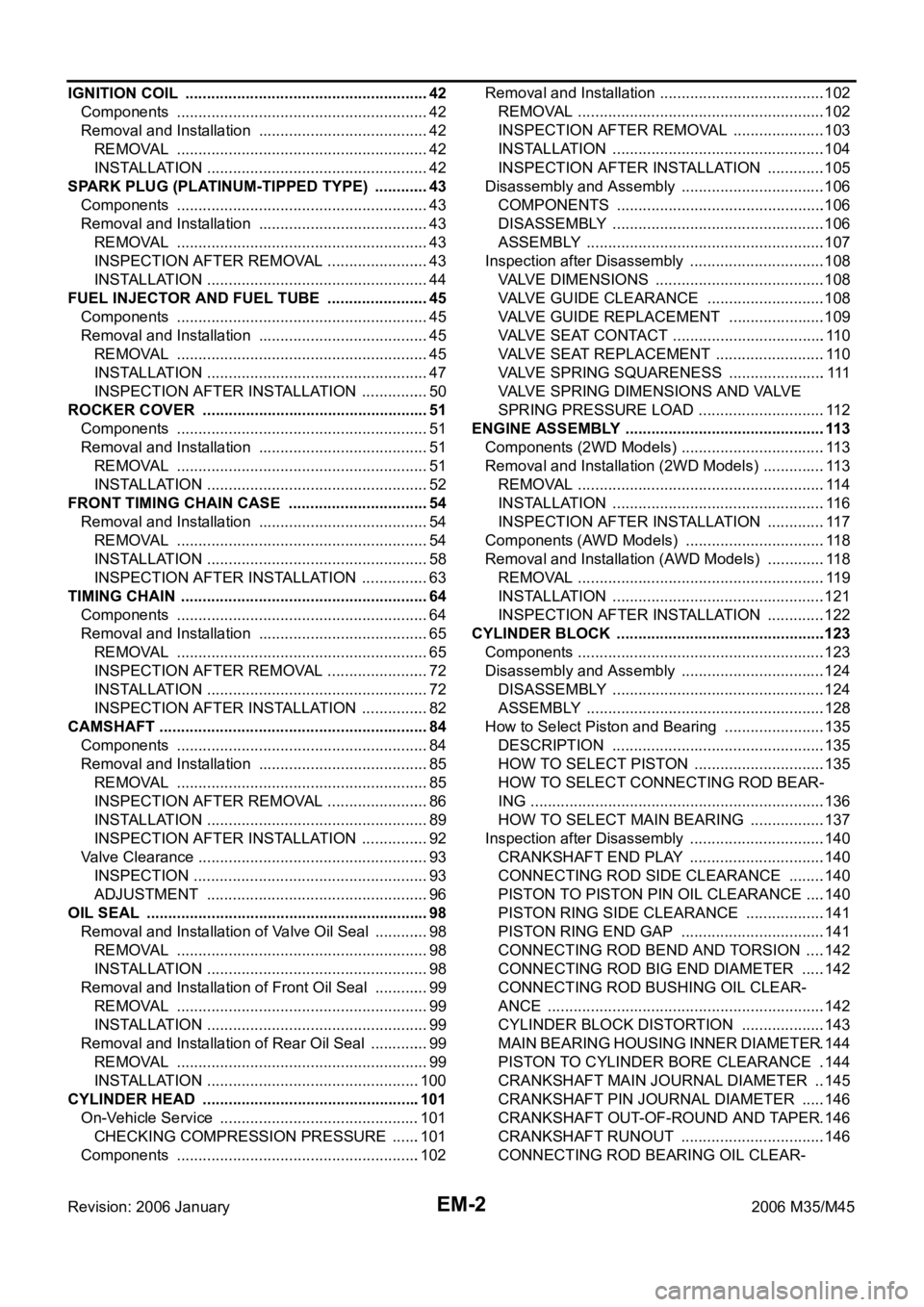
EM-2Revision: 2006 January2006 M35/M45 IGNITION COIL ......................................................... 42
Components ........................................................... 42
Removal and Installation ........................................ 42
REMOVAL ........................................................
... 42
INSTALLATION .................................................... 42
SPARK PLUG (PLATINUM-TIPPED TYPE) ............. 43
Components ........................................................... 43
Removal and Installation ........................................ 43
REMOVAL ........................................................
... 43
INSPECTION AFTER REMOVAL ........................ 43
INSTALLATION .................................................... 44
FUEL INJECTOR AND FUEL TUBE ........................ 45
Components ........................................................... 45
Removal and Installation ........................................ 45
REMOVAL ........................................................
... 45
INSTALLATION .................................................... 47
INSPECTION AFTER INSTALLATION ................ 50
ROCKER COVER ..................................................... 51
Components ........................................................... 51
Removal and Installation ........................................ 51
REMOVAL ........................................................
... 51
INSTALLATION .................................................... 52
FRONT TIMING CHAIN CASE ................................. 54
Removal and Installation ........................................ 54
REMOVAL ........................................................
... 54
INSTALLATION .................................................... 58
INSPECTION AFTER INSTALLATION ................ 63
TIMING CHAIN .......................................................... 64
Components ........................................................... 64
Removal and Installation ........................................ 65
REMOVAL ........................................................
... 65
INSPECTION AFTER REMOVAL ........................ 72
INSTALLATION .................................................... 72
INSPECTION AFTER INSTALLATION ................ 82
CAMSHAFT ............................................................... 84
Components ........................................................... 84
Removal and Installation ........................................ 85
REMOVAL ........................................................
... 85
INSPECTION AFTER REMOVAL ........................ 86
INSTALLATION .................................................... 89
INSPECTION AFTER INSTALLATION ................ 92
Valve Clearance ...................................................... 93
INSPECTION ....................................................... 93
ADJUSTMENT .................................................... 96
OIL SEAL ......................................................
............ 98
Removal and Installation of Valve Oil Seal ............. 98
REMOVAL ........................................................
... 98
INSTALLATION .................................................... 98
Removal and Installation of Front Oil Seal ............. 99
REMOVAL ........................................................
... 99
INSTALLATION .................................................... 99
Removal and Installation of Rear Oil Seal .............. 99
REMOVAL ........................................................
... 99
INSTALLATION ..................................................100
CYLINDER HEAD .................................................. .101
On-Vehicle Service ...............................................101
CHECKING COMPRESSION PRESSURE .......101
Components .........................................................102Removal and Installation .......................................102
REMOVAL ..........................................................102
INSPECTION AFTER REMOVAL ......................103
INSTALLATION ..................................................104
INSPECTION AFTER INSTALLATION ..............105
Disassembly and Assembly ..................................106
COMPONENTS .................................................106
DISASSEMBLY ..................................................106
ASSEMBLY ........................................................107
Inspection after Disassembly ................................108
VALVE DIMENSIONS ........................................108
VALVE GUIDE CLEARANCE ............................108
VALVE GUIDE REPLACEMENT .......................109
VALVE SEAT CONTACT ....................................110
VALVE SEAT REPLACEMENT ..........................110
VALVE SPRING SQUARENESS ....................... 111
VALVE SPRING DIMENSIONS AND VALVE
SPRING PRESSURE LOAD ..............................112
ENGINE ASSEMBLY ...............................................113
Components (2WD Models) ..................................113
Removal and Installation (2WD Models) ...............113
REMOVAL ..........................................................114
INSTALLATION ..................................................116
INSPECTION AFTER INSTALLATION ..............117
Components (AWD Models) .................................118
Removal and Installation (AWD Models) ..............118
REMOVAL ..........................................................119
INSTALLATION ..................................................121
INSPECTION AFTER INSTALLATION ..............122
CYLINDER BLOCK .................................................123
Components ..........................................................123
Disassembly and Assembly ..................................124
DISASSEMBLY ..................................................124
ASSEMBLY ......................................................
..128
How to Select Piston and Bearing ........................135
DESCRIPTION ..................................................135
HOW TO SELECT PISTON ...............................135
HOW TO SELECT CONNECTING ROD BEAR-
ING .....................................................................136
HOW TO SELECT MAIN BEARING ..................137
Inspection after Disassembly ................................140
CRANKSHAFT END PLAY ................................140
CONNECTING ROD SIDE CLEARANCE .........140
PISTON TO PISTON PIN OIL CLEARANCE .....140
PISTON RING SIDE CLEARANCE ...................141
PISTON RING END GAP ..................................141
CONNECTING ROD BEND AND TORSION .....142
CONNECTING ROD BIG END DIAMETER ......142
CONNECTING ROD BUSHING OIL CLEAR-
ANCE .................................................................142
CYLINDER BLOCK DISTORTION ....................143
MAIN BEARING HOUSING INNER DIAMETER .144
PISTON TO CYLINDER BORE CLEARANCE ..144
CRANKSHAFT MAIN JOURNAL DIAMETER ...145
CRANKSHAFT PIN JOURNAL DIAMETER ......146
CRANKSHAFT OUT-OF-ROUND AND TAPER .146
CRANKSHAFT RUNOUT ..................................146
CONNECTING ROD BEARING OIL CLEAR-
Page 3067 of 5621
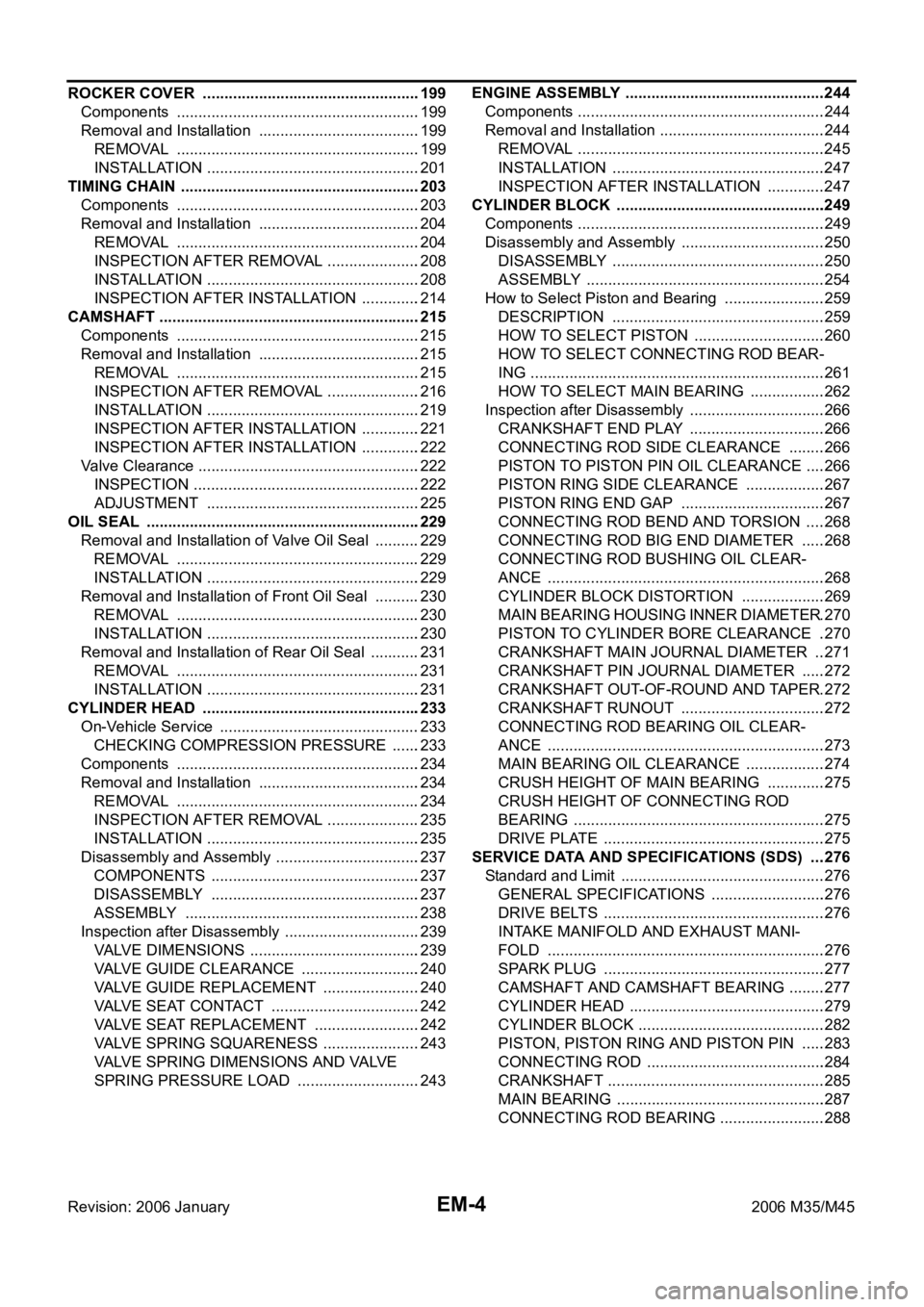
EM-4Revision: 2006 January2006 M35/M45 ROCKER COVER ...................................................199
Components .........................................................199
Removal and Installation ......................................199
REMOVAL ........................................................
.199
INSTALLATION ..................................................201
TIMING CHAIN ........................................................203
Components .........................................................203
Removal and Installation ......................................204
REMOVAL ........................................................
.204
INSPECTION AFTER REMOVAL ......................208
INSTALLATION ..................................................208
INSPECTION AFTER INSTALLATION ..............214
CAMSHAFT .............................................................215
Components .........................................................215
Removal and Installation ......................................215
REMOVAL ........................................................
.215
INSPECTION AFTER REMOVAL ......................216
INSTALLATION ..................................................219
INSPECTION AFTER INSTALLATION ..............221
INSPECTION AFTER INSTALLATION ..............222
Valve Clearance ....................................................222
INSPECTION .....................................................222
ADJUSTMENT ..................................................225
OIL SEAL ................................................................229
Removal and Installation of Valve Oil Seal ...........229
REMOVAL ........................................................
.229
INSTALLATION ..................................................229
Removal and Installation of Front Oil Seal ...........230
REMOVAL ........................................................
.230
INSTALLATION ..................................................230
Removal and Installation of Rear Oil Seal ............231
REMOVAL ........................................................
.231
INSTALLATION ..................................................231
CYLINDER HEAD .................................................. .233
On-Vehicle Service ...............................................233
CHECKING COMPRESSION PRESSURE .......233
Components .........................................................234
Removal and Installation ......................................234
REMOVAL ........................................................
.234
INSPECTION AFTER REMOVAL ......................235
INSTALLATION ..................................................235
Disassembly and Assembly ..................................237
COMPONENTS .................................................237
DISASSEMBLY .................................................237
ASSEMBLY ......................................................
.238
Inspection after Disassembly ................................239
VALVE DIMENSIONS ........................................239
VALVE GUIDE CLEARANCE ............................240
VALVE GUIDE REPLACEMENT .......................240
VALVE SEAT CONTACT ...................................242
VALVE SEAT REPLACEMENT .........................242
VALVE SPRING SQUARENESS .......................243
VALVE SPRING DIMENSIONS AND VALVE
SPRING PRESSURE LOAD .............................243ENGINE ASSEMBLY ...............................................244
Components ..........................................................244
Removal and Installation .......................................244
REMOVAL ..........................................................245
INSTALLATION ..................................................247
INSPECTION AFTER INSTALLATION ..............247
CYLINDER BLOCK .................................................249
Components ..........................................................249
Disassembly and Assembly ..................................250
DISASSEMBLY ..................................................250
ASSEMBLY ........................................................254
How to Select Piston and Bearing ........................259
DESCRIPTION ..................................................259
HOW TO SELECT PISTON ...............................260
HOW TO SELECT CONNECTING ROD BEAR-
ING .....................................................................261
HOW TO SELECT MAIN BEARING ..................262
Inspection after Disassembly ................................266
CRANKSHAFT END PLAY ................................266
CONNECTING ROD SIDE CLEARANCE .........266
PISTON TO PISTON PIN OIL CLEARANCE .....266
PISTON RING SIDE CLEARANCE ...................267
PISTON RING END GAP ..................................267
CONNECTING ROD BEND AND TORSION .....268
CONNECTING ROD BIG END DIAMETER ......268
CONNECTING ROD BUSHING OIL CLEAR-
ANCE .................................................................268
CYLINDER BLOCK DISTORTION ....................269
MAIN BEARING HOUSING INNER DIAMETER .270
PISTON TO CYLINDER BORE CLEARANCE ..270
CRANKSHAFT MAIN JOURNAL DIAMETER ...271
CRANKSHAFT PIN JOURNAL DIAMETER ......272
CRANKSHAFT OUT-OF-ROUND AND TAPER .272
CRANKSHAFT RUNOUT ..................................272
CONNECTING ROD BEARING OIL CLEAR-
ANCE .................................................................273
MAIN BEARING OIL CLEARANCE ...................274
CRUSH HEIGHT OF MAIN BEARING ..............275
CRUSH HEIGHT OF CONNECTING ROD
BEARING ...........................................................275
DRIVE PLATE ....................................................275
SERVICE DATA AND SPECIFICATIONS (SDS) ....276
Standard and Limit ................................................276
GENERAL SPECIFICATIONS ...........................276
DRIVE BELTS ....................................................276
INTAKE MANIFOLD AND EXHAUST MANI-
FOLD .................................................................276
SPARK PLUG ....................................................277
CAMSHAFT AND CAMSHAFT BEARING .........277
CYLINDER HEAD ..............................................279
CYLINDER BLOCK ............................................282
PISTON, PISTON RING AND PISTON PIN ......283
CONNECTING ROD ..........................................284
CRANKSHAFT ...................................................285
MAIN BEARING .................................................287
CONNECTING ROD BEARING .........................288
Page 3387 of 5621
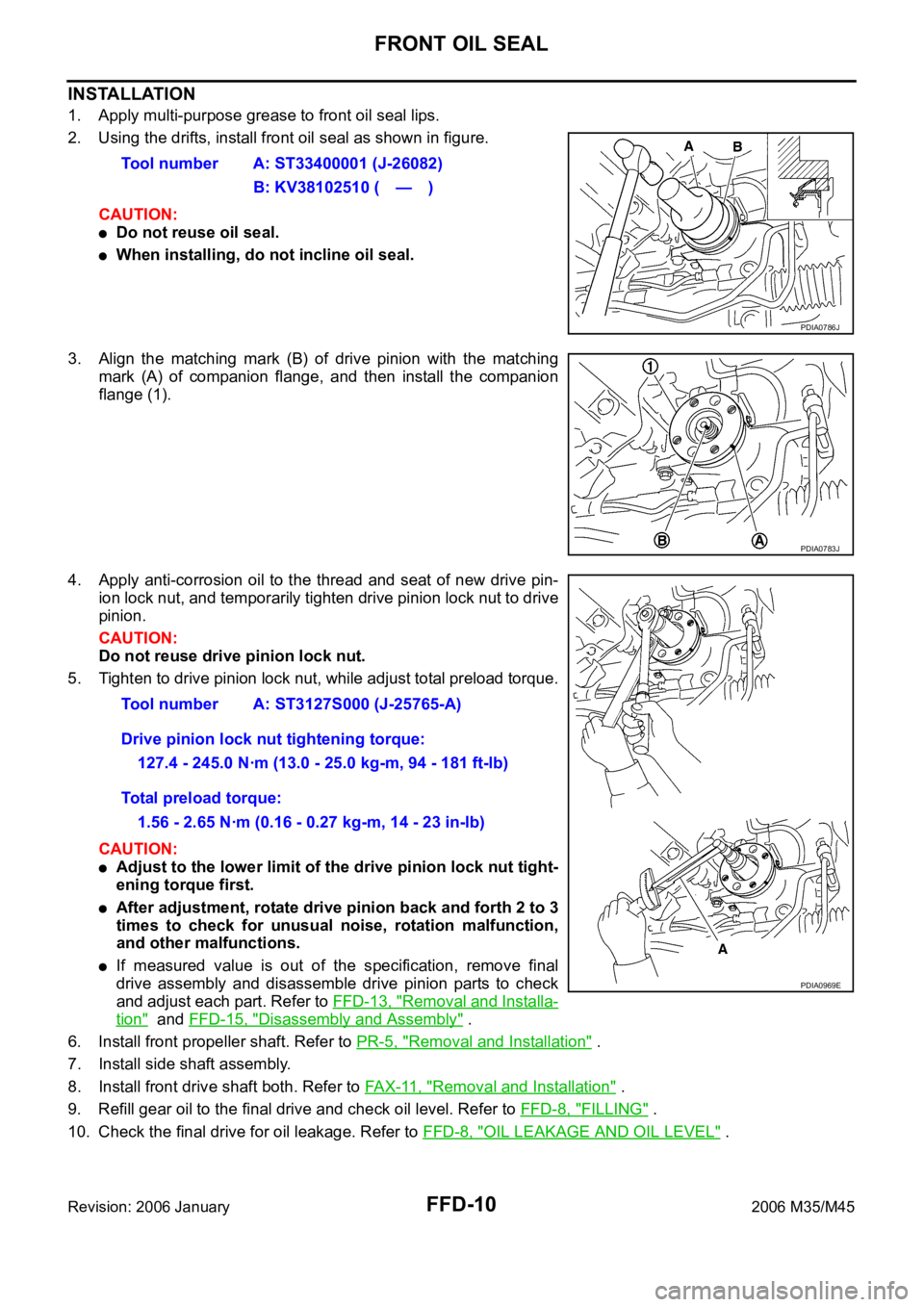
FFD-10
FRONT OIL SEAL
Revision: 2006 January2006 M35/M45
INSTALLATION
1. Apply multi-purpose grease to front oil seal lips.
2. Using the drifts, install front oil seal as shown in figure.
CAUTION:
Do not reuse oil seal.
When installing, do not incline oil seal.
3. Align the matching mark (B) of drive pinion with the matching
mark (A) of companion flange, and then install the companion
flange (1).
4. Apply anti-corrosion oil to the thread and seat of new drive pin-
ion lock nut, and temporarily tighten drive pinion lock nut to drive
pinion.
CAUTION:
Do not reuse drive pinion lock nut.
5. Tighten to drive pinion lock nut, while adjust total preload torque.
CAUTION:
Adjust to the lower limit of the drive pinion lock nut tight-
ening torque first.
After adjustment, rotate drive pinion back and forth 2 to 3
times to check for unusual noise, rotation malfunction,
and other malfunctions.
If measured value is out of the specification, remove final
drive assembly and disassemble drive pinion parts to check
and adjust each part. Refer to FFD-13, "
Removal and Installa-
tion" and FFD-15, "Disassembly and Assembly" .
6. Install front propeller shaft. Refer to PR-5, "
Removal and Installation" .
7. Install side shaft assembly.
8. Install front drive shaft both. Refer to FA X - 11 , "
Removal and Installation" .
9. Refill gear oil to the final drive and check oil level. Refer to FFD-8, "
FILLING" .
10. Check the final drive for oil leakage. Refer to FFD-8, "
OIL LEAKAGE AND OIL LEVEL" . Tool number A: ST33400001 (J-26082)
B: KV38102510 ( — )
PDIA0786J
PDIA0783J
Tool number A: ST3127S000 (J-25765-A)
Drive pinion lock nut tightening torque:
127.4 - 245.0 Nꞏm (13.0 - 25.0 kg-m, 94 - 181 ft-lb)
Total preload torque:
1.56 - 2.65 Nꞏm (0.16 - 0.27 kg-m, 14 - 23 in-lb)
PDIA0969E
Page 3407 of 5621
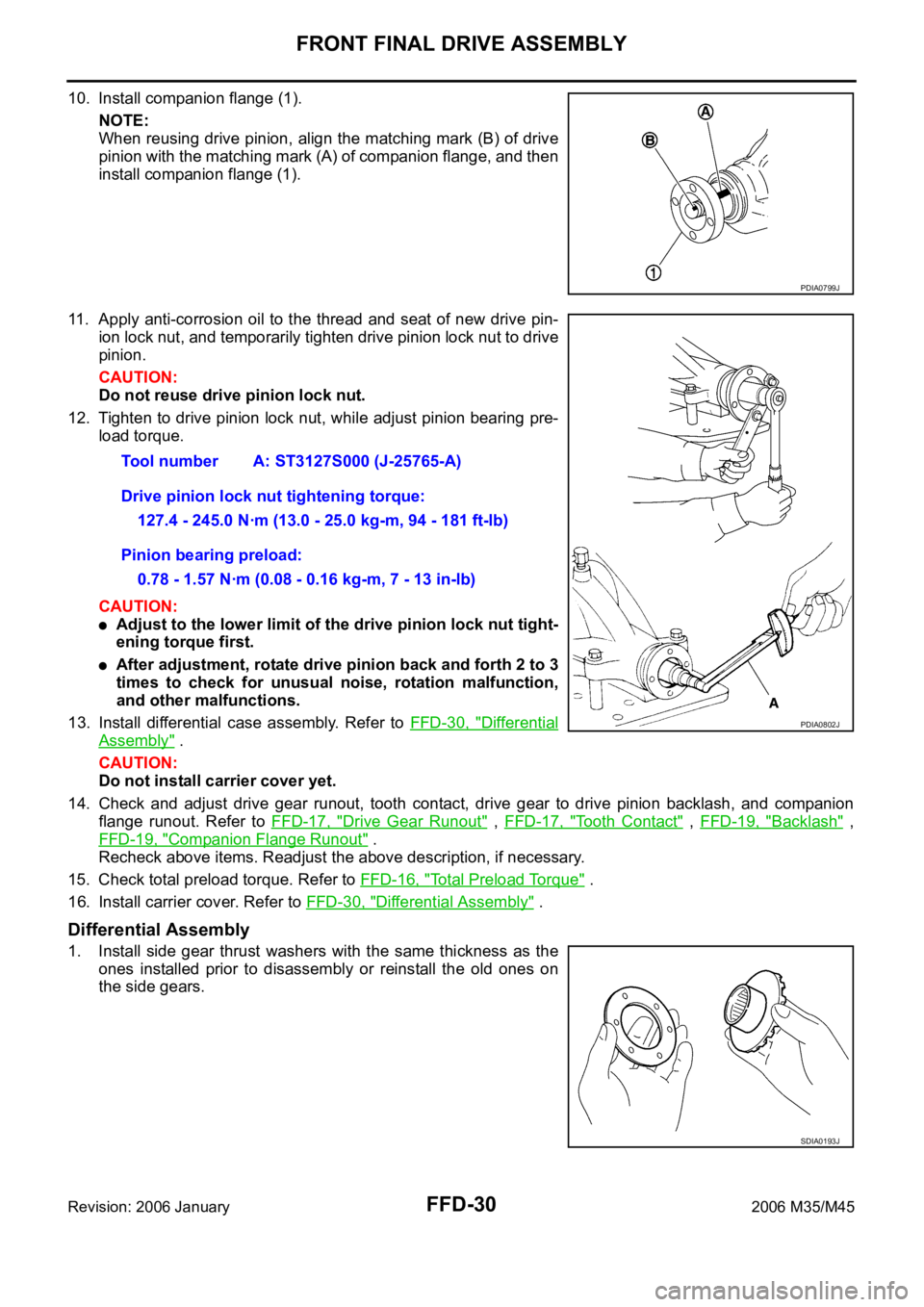
FFD-30
FRONT FINAL DRIVE ASSEMBLY
Revision: 2006 January2006 M35/M45
10. Install companion flange (1).
NOTE:
When reusing drive pinion, align the matching mark (B) of drive
pinion with the matching mark (A) of companion flange, and then
install companion flange (1).
11. Apply anti-corrosion oil to the thread and seat of new drive pin-
ion lock nut, and temporarily tighten drive pinion lock nut to drive
pinion.
CAUTION:
Do not reuse drive pinion lock nut.
12. Tighten to drive pinion lock nut, while adjust pinion bearing pre-
load torque.
CAUTION:
Adjust to the lower limit of the drive pinion lock nut tight-
ening torque first.
After adjustment, rotate drive pinion back and forth 2 to 3
times to check for unusual noise, rotation malfunction,
and other malfunctions.
13. Install differential case assembly. Refer to FFD-30, "
Differential
Assembly" .
CAUTION:
Do not install carrier cover yet.
14. Check and adjust drive gear runout, tooth contact, drive gear to drive pinion backlash, and companion
flange runout. Refer to FFD-17, "
Drive Gear Runout" , FFD-17, "Tooth Contact" , FFD-19, "Backlash" ,
FFD-19, "
Companion Flange Runout" .
Recheck above items. Readjust the above description, if necessary.
15. Check total preload torque. Refer to FFD-16, "
Total Preload Torque" .
16. Install carrier cover. Refer to FFD-30, "
Differential Assembly" .
Differential Assembly
1. Install side gear thrust washers with the same thickness as the
ones installed prior to disassembly or reinstall the old ones on
the side gears.
PDIA0799J
Tool number A: ST3127S000 (J-25765-A)
Drive pinion lock nut tightening torque:
127.4 - 245.0 Nꞏm (13.0 - 25.0 kg-m, 94 - 181 ft-lb)
Pinion bearing preload:
0.78 - 1.57 Nꞏm (0.08 - 0.16 kg-m, 7 - 13 in-lb)
PDIA0802J
SDIA0193J
Page 3527 of 5621
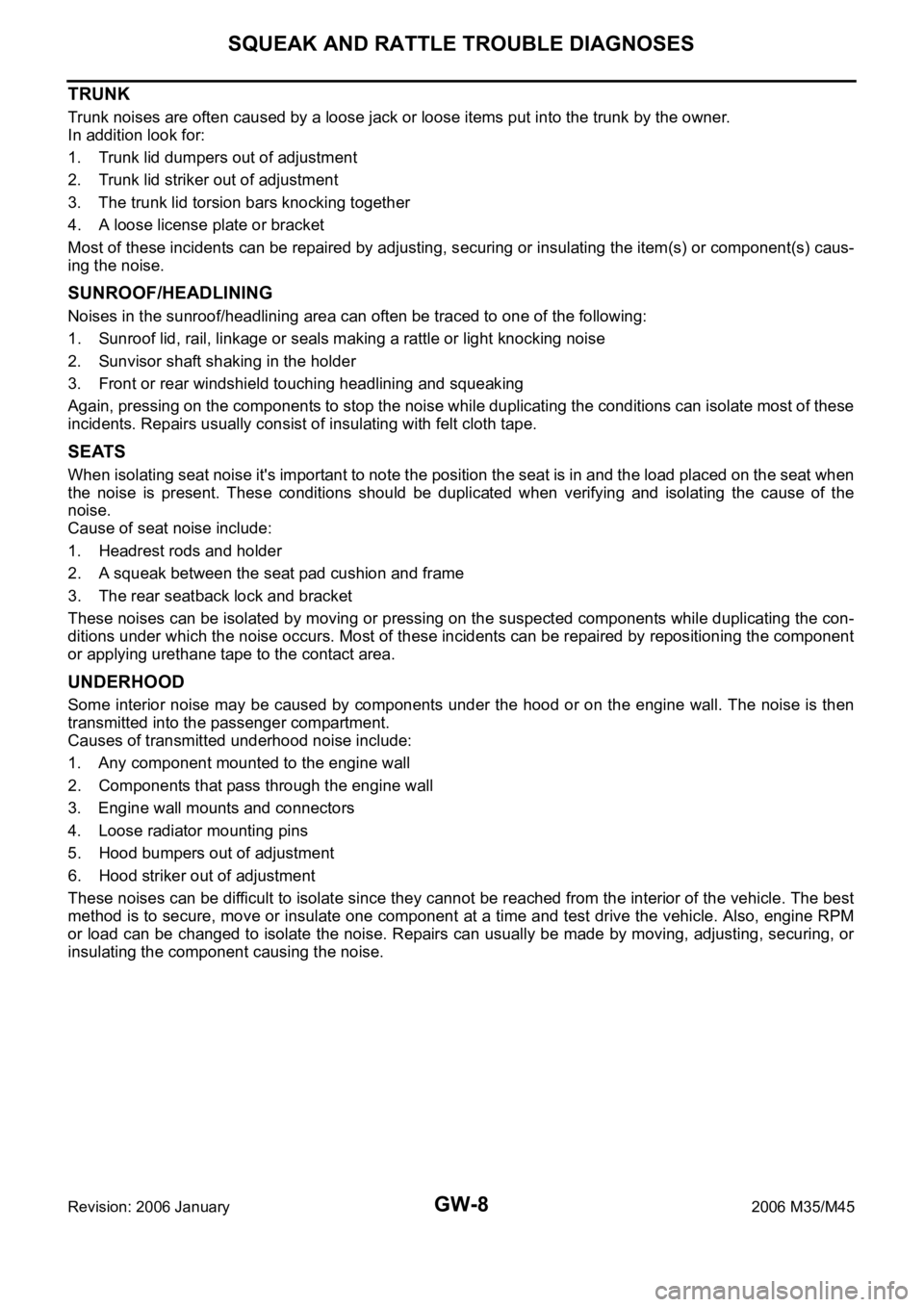
GW-8
SQUEAK AND RATTLE TROUBLE DIAGNOSES
Revision: 2006 January2006 M35/M45
TRUNK
Trunk noises are often caused by a loose jack or loose items put into the trunk by the owner.
In addition look for:
1. Trunk lid dumpers out of adjustment
2. Trunk lid striker out of adjustment
3. The trunk lid torsion bars knocking together
4. A loose license plate or bracket
Most of these incidents can be repaired by adjusting, securing or insulating the item(s) or component(s) caus-
ing the noise.
SUNROOF/HEADLINING
Noises in the sunroof/headlining area can often be traced to one of the following:
1. Sunroof lid, rail, linkage or seals making a rattle or light knocking noise
2. Sunvisor shaft shaking in the holder
3. Front or rear windshield touching headlining and squeaking
Again, pressing on the components to stop the noise while duplicating the conditions can isolate most of these
incidents. Repairs usually consist of insulating with felt cloth tape.
SEATS
When isolating seat noise it's important to note the position the seat is in and the load placed on the seat when
the noise is present. These conditions should be duplicated when verifying and isolating the cause of the
noise.
Cause of seat noise include:
1. Headrest rods and holder
2. A squeak between the seat pad cushion and frame
3. The rear seatback lock and bracket
These noises can be isolated by moving or pressing on the suspected components while duplicating the con-
ditions under which the noise occurs. Most of these incidents can be repaired by repositioning the component
or applying urethane tape to the contact area.
UNDERHOOD
Some interior noise may be caused by components under the hood or on the engine wall. The noise is then
transmitted into the passenger compartment.
Causes of transmitted underhood noise include:
1. Any component mounted to the engine wall
2. Components that pass through the engine wall
3. Engine wall mounts and connectors
4. Loose radiator mounting pins
5. Hood bumpers out of adjustment
6. Hood striker out of adjustment
These noises can be difficult to isolate since they cannot be reached from the interior of the vehicle. The best
method is to secure, move or insulate one component at a time and test drive the vehicle. Also, engine RPM
or load can be changed to isolate the noise. Repairs can usually be made by moving, adjusting, securing, or
insulating the component causing the noise.
Page 3615 of 5621
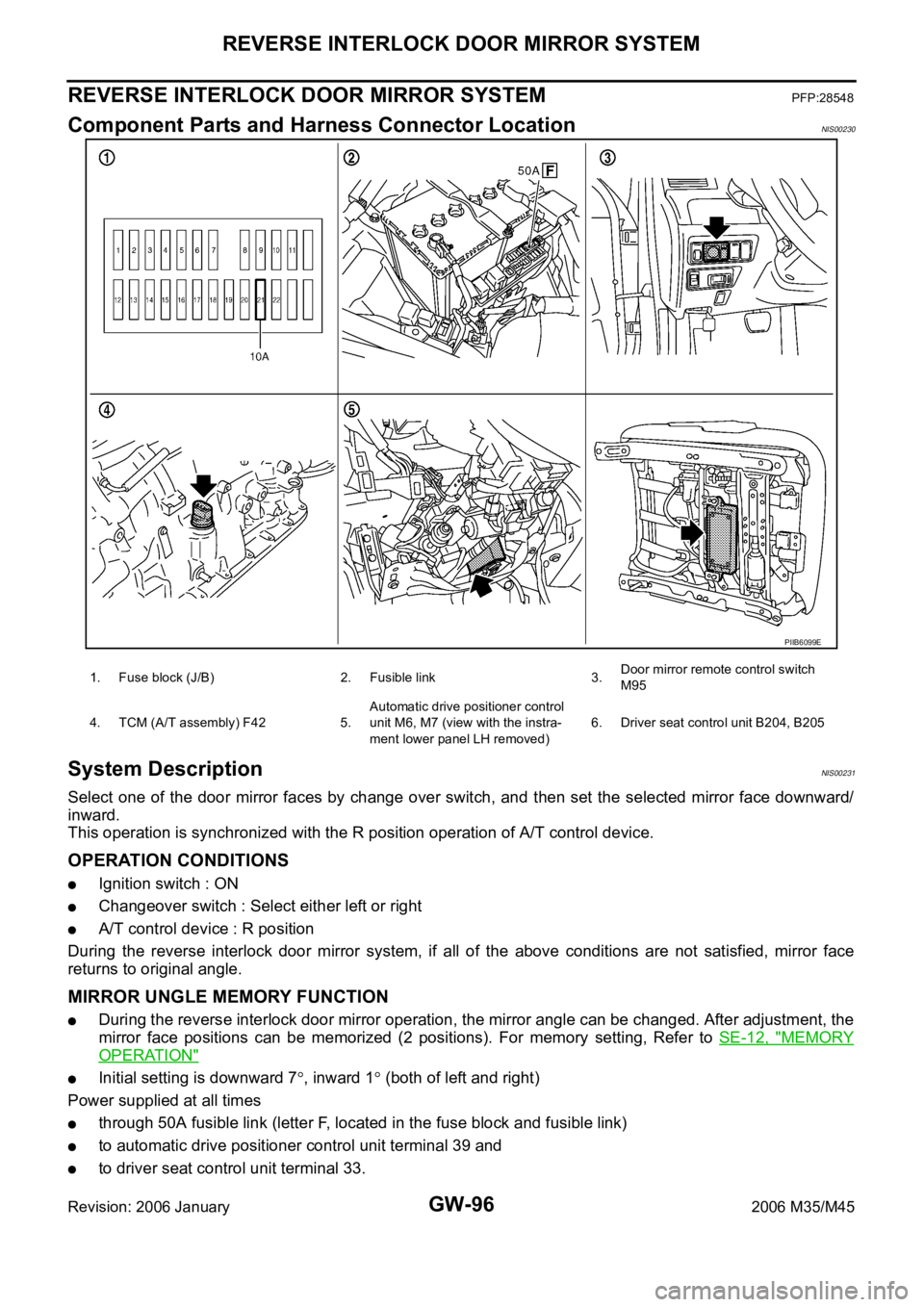
GW-96
REVERSE INTERLOCK DOOR MIRROR SYSTEM
Revision: 2006 January2006 M35/M45
REVERSE INTERLOCK DOOR MIRROR SYSTEMPFP:28548
Component Parts and Harness Connector LocationNIS00230
System DescriptionNIS00231
Select one of the door mirror faces by change over switch, and then set the selected mirror face downward/
inward.
This operation is synchronized with the R position operation of A/T control device.
OPERATION CONDITIONS
Ignition switch : ON
Changeover switch : Select either left or right
A/T control device : R position
During the reverse interlock door mirror system, if all of the above conditions are not satisfied, mirror face
returns to original angle.
MIRROR UNGLE MEMORY FUNCTION
During the reverse interlock door mirror operation, the mirror angle can be changed. After adjustment, the
mirror face positions can be memorized (2 positions). For memory setting, Refer to SE-12, "
MEMORY
OPERATION"
Initial setting is downward 7, inward 1 (both of left and right)
Power supplied at all times
through 50A fusible link (letter F, located in the fuse block and fusible link)
to automatic drive positioner control unit terminal 39 and
to driver seat control unit terminal 33.
PIIB6099E
1. Fuse block (J/B) 2. Fusible link 3.Door mirror remote control switch
M95
4. TCM (A/T assembly) F42 5.Automatic drive positioner control
unit M6, M7 (view with the instra-
ment lower panel LH removed)6. Driver seat control unit B204, B205
Page 3646 of 5621
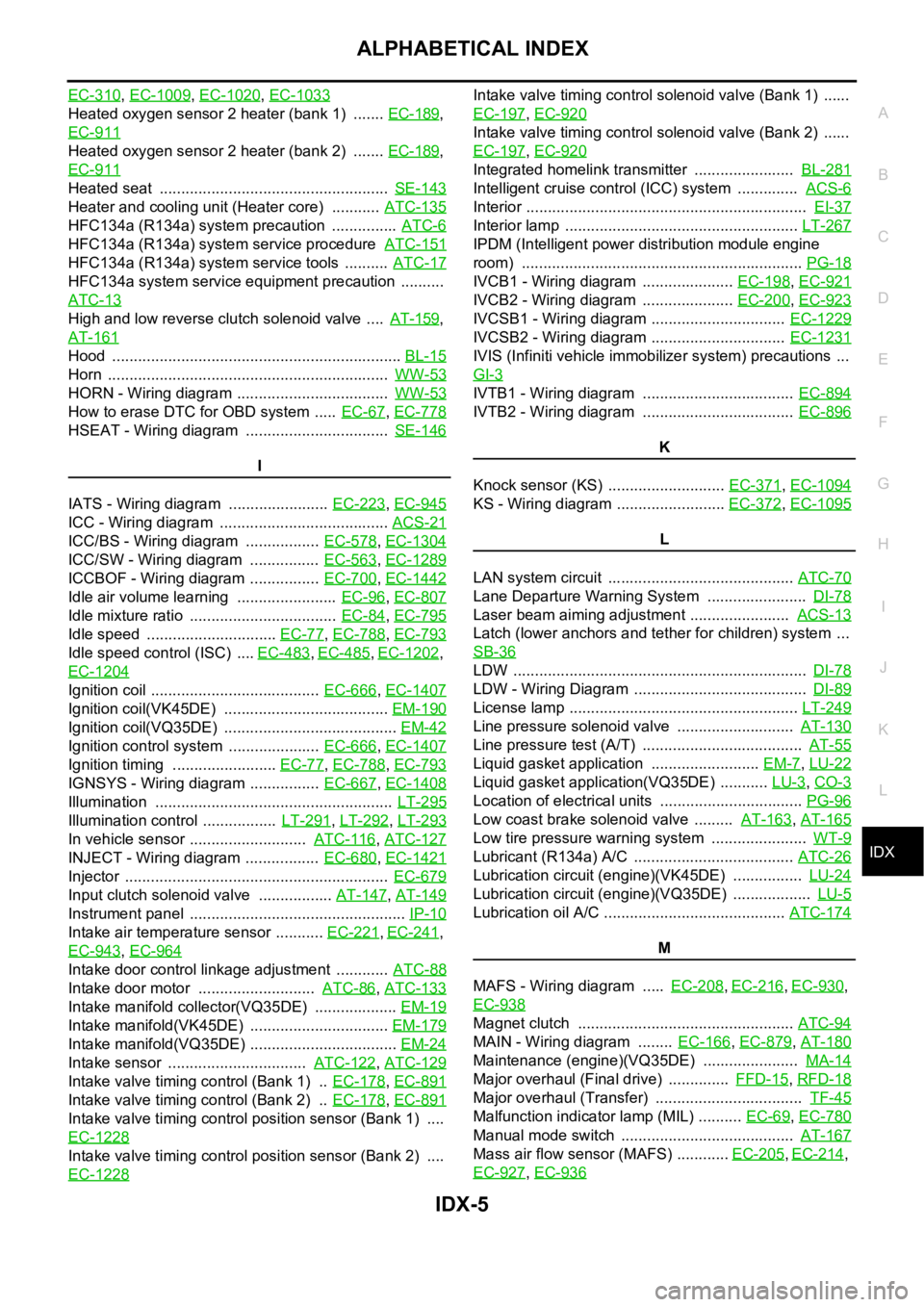
IDX-5
A
C
D
E
F
G
H
I
J
K
L B
IDX
ALPHABETICAL INDEX
EC-310, EC-1009, EC-1020, EC-1033
Heated oxygen sensor 2 heater (bank 1) ....... EC-189,
EC-911
Heated oxygen sensor 2 heater (bank 2) ....... EC-189,
EC-911
Heated seat ..................................................... SE-143
Heater and cooling unit (Heater core) ........... ATC-135
HFC134a (R134a) system precaution ............... ATC-6
HFC134a (R134a) system service procedure ATC-151
HFC134a (R134a) system service tools .......... ATC-17
HFC134a system service equipment precaution ..........
ATC-13
High and low reverse clutch solenoid valve .... AT-159,
AT-161
Hood ................................................................... BL-15
Horn ................................................................. WW-53
HORN - Wiring diagram ................................... WW-53
How to erase DTC for OBD system ..... EC-67, EC-778
HSEAT - Wiring diagram ................................. SE-146
I
IATS - Wiring diagram ....................... EC-223
, EC-945
ICC - Wiring diagram ....................................... ACS-21
ICC/BS - Wiring diagram ................. EC-578, EC-1304
ICC/SW - Wiring diagram ................ EC-563, EC-1289
ICCBOF - Wiring diagram ................ EC-700, EC-1442
Idle air volume learning ....................... EC-96, EC-807
Idle mixture ratio .................................. EC-84, EC-795
Idle speed .............................. EC-77, EC-788, EC-793
Idle speed control (ISC) .... EC-483, EC-485, EC-1202,
EC-1204
Ignition coil ....................................... EC-666, EC-1407
Ignition coil(VK45DE) ...................................... EM-190
Ignition coil(VQ35DE) ........................................ EM-42
Ignition control system ..................... EC-666, EC-1407
Ignition timing ........................ EC-77, EC-788, EC-793
IGNSYS - Wiring diagram ................ EC-667, EC-1408
Illumination ....................................................... LT-295
Illumination control ................. LT-291, LT-292, LT-293
In vehicle sensor ........................... ATC-116, ATC-127
INJECT - Wiring diagram ................. EC-680, EC-1421
Injector ............................................................. EC-679
Input clutch solenoid valve ................. AT-147, AT-149
Instrument panel .................................................. IP-10
Intake air temperature sensor ........... EC-221, EC-241,
EC-943
, EC-964
Intake door control linkage adjustment ............ ATC-88
Intake door motor ........................... ATC-86, ATC-133
Intake manifold collector(VQ35DE) ................... EM-19
Intake manifold(VK45DE) ................................ EM-179
Intake manifold(VQ35DE) .................................. EM-24
Intake sensor ................................ ATC-122, ATC-129
Intake valve timing control (Bank 1) .. EC-178, EC-891
Intake valve timing control (Bank 2) .. EC-178, EC-891
Intake valve timing control position sensor (Bank 1) ....
EC-1228
Intake valve timing control position sensor (Bank 2) ....
EC-1228
Intake valve timing control solenoid valve (Bank 1) ......
EC-197
, EC-920
Intake valve timing control solenoid valve (Bank 2) ......
EC-197
, EC-920
Integrated homelink transmitter ....................... BL-281
Intelligent cruise control (ICC) system .............. ACS-6
Interior ................................................................. EI-37
Interior lamp ...................................................... LT-267
IPDM (Intelligent power distribution module engine
room) ................................................................. PG-18
IVCB1 - Wiring diagram ..................... EC-198, EC-921
IVCB2 - Wiring diagram ..................... EC-200, EC-923
IVCSB1 - Wiring diagram ............................... EC-1229
IVCSB2 - Wiring diagram ............................... EC-1231
IVIS (Infiniti vehicle immobilizer system) precautions ...
GI-3
IVTB1 - Wiring diagram ................................... EC-894
IVTB2 - Wiring diagram ................................... EC-896
K
Knock sensor (KS) ........................... EC-371
, EC-1094
KS - Wiring diagram ......................... EC-372, EC-1095
L
LAN system circuit ........................................... ATC-70
Lane Departure Warning System ....................... DI-78
Laser beam aiming adjustment ....................... ACS-13
Latch (lower anchors and tether for children) system ...
SB-36
LDW .................................................................... DI-78
LDW - Wiring Diagram ........................................ DI-89
License lamp ..................................................... LT-249
Line pressure solenoid valve ........................... AT-130
Line pressure test (A/T) ..................................... AT-55
Liquid gasket application ......................... EM-7, LU-22
Liquid gasket application(VQ35DE) ........... LU-3, CO-3
Location of electrical units ................................. PG-96
Low coast brake solenoid valve ......... AT-163, AT-165
Low tire pressure warning system ...................... WT-9
Lubricant (R134a) A/C ..................................... ATC-26
Lubrication circuit (engine)(VK45DE) ................ LU-24
Lubrication circuit (engine)(VQ35DE) .................. LU-5
Lubrication oil A/C .......................................... ATC-174
M
MAFS - Wiring diagram ..... EC-208
, EC-216, EC-930,
EC-938
Magnet clutch .................................................. ATC-94
MAIN - Wiring diagram ........ EC-166, EC-879, AT-180
Maintenance (engine)(VQ35DE) ...................... MA-14
Major overhaul (Final drive) .............. FFD-15, RFD-18
Major overhaul (Transfer) .................................. TF-45
Malfunction indicator lamp (MIL) .......... EC-69, EC-780
Manual mode switch ........................................ AT-167
Mass air flow sensor (MAFS) ............ EC-205, EC-214,
EC-927
, EC-936
Page 3656 of 5621

SQUEAK AND RATTLE TROUBLE DIAGNOSES
IP-7
C
D
E
F
G
H
J
K
L
MA
B
IP
Revision: 2006 January2006 M35/M45
TRUNK
Trunk noises are often caused by a loose jack or loose items put into the trunk by the owner.
In addition look for:
1. Trunk lid dumpers out of adjustment
2. Trunk lid striker out of adjustment
3. The trunk lid torsion bars knocking together
4. A loose license plate or bracket
Most of these incidents can be repaired by adjusting, securing or insulating the item(s) or component(s) caus-
ing the noise.
SUNROOF/HEADLINING
Noises in the sunroof/headlining area can often be traced to one of the following:
1. Sunroof lid, rail, linkage or seals making a rattle or light knocking noise
2. Sunvisor shaft shaking in the holder
3. Front or rear windshield touching headlining and squeaking
Again, pressing on the components to stop the noise while duplicating the conditions can isolate most of these
incidents. Repairs usually consist of insulating with felt cloth tape.
SEATS
When isolating seat noise it's important to note the position the seat is in and the load placed on the seat when
the noise is present. These conditions should be duplicated when verifying and isolating the cause of the
noise.
Cause of seat noise include:
1. Headrest rods and holder
2. A squeak between the seat pad cushion and frame
3. The rear seatback lock and bracket
These noises can be isolated by moving or pressing on the suspected components while duplicating the con-
ditions under which the noise occurs. Most of these incidents can be repaired by repositioning the component
or applying urethane tape to the contact area.
UNDERHOOD
Some interior noise may be caused by components under the hood or on the engine wall. The noise is then
transmitted into the passenger compartment.
Causes of transmitted underhood noise include:
1. Any component mounted to the engine wall
2. Components that pass through the engine wall
3. Engine wall mounts and connectors
4. Loose radiator mounting pins
5. Hood bumpers out of adjustment
6. Hood striker out of adjustment
These noises can be difficult to isolate since they cannot be reached from the interior of the vehicle. The best
method is to secure, move or insulate one component at a time and test drive the vehicle. Also, engine RPM
or load can be changed to isolate the noise. Repairs can usually be made by moving, adjusting, securing, or
insulating the component causing the noise.